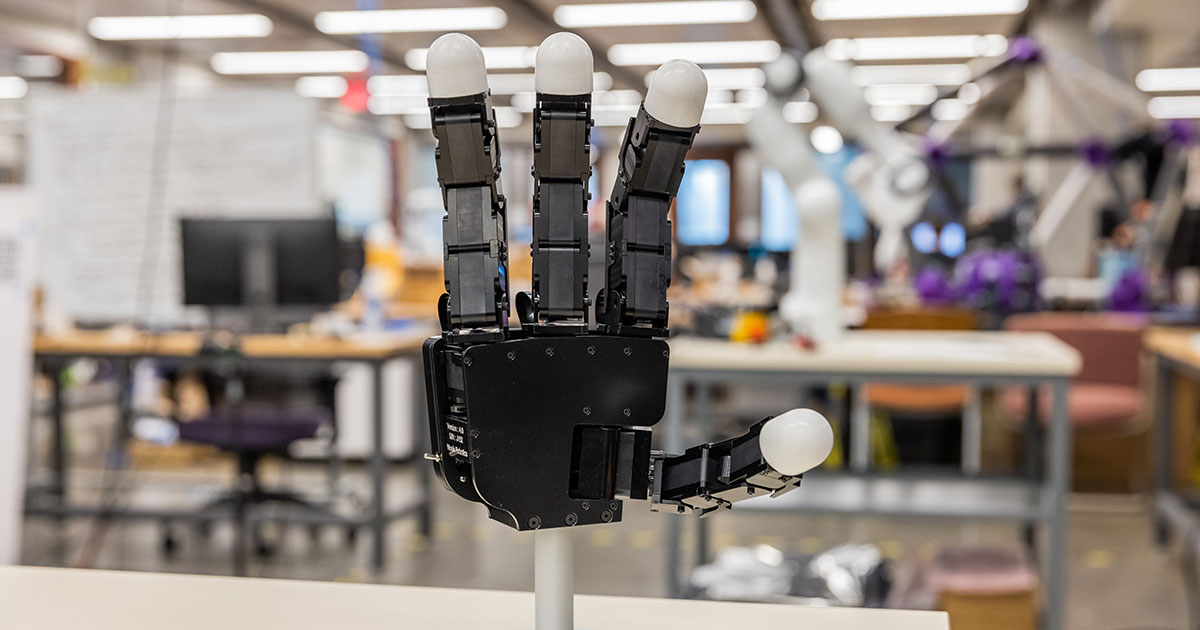MSR Students Get Hands-On Time with Wide Range of Robots
Students in Northwestern Engineering's Master of Science in Robotics (MSR) program are outnumbered by the number of robots available to them — and that's a good thing, according to deputy director Matt Elwin.

Students in Northwestern Engineering's Master of Science in Robotics (MSR) program learn to launch robotics careers thanks to a number of hands-on project opportunities. That emphasis on learning by doing leads to a common question from prospective students, according to MSR deputy director Matt Elwin: what is the student-to-robot ratio?
Elwin happily responds that in MSR, there are more robots than students.
The MSR program has more than 50 robots, ranging from desktop-sized mobile robots to quadrotors and industrial-sized robotic arms. The quantity ensures students have ample opportunities to learn how the robotic systems work first hand, while the variety is meant to expose students to an array of tools and applications for the different robots.
"On one end of the spectrum you can work with a small robot that doesn't lift very much, is relatively slow and unsophisticated," Elwin said. "Working with that gives you the most freedom to explore. You’re not going to mess anything up, and that takes a lot of the pressure off when you’re working with it. On the other hand, there are more sophisticated robots that allow you to do more things with them but come with added precautions, so it's important to have a balance."
MSR students go through a progression of robots during their time in the program. Students begin by learning to work with smaller devices, including a Robotis Turtlebot3 mobile robot, a Trossen PincherX Robot Arm, and an Intel Realsense depth camera, allowing them to learn how to manipulate objects, run navigation algorithms, and build three-dimensional maps of their surroundings.
During their second quarter in the program, students branch out as they pursue an independent project of their choosing. Depending on the project topics and robots needed, it is common for students to have access to a robot for the length of the quarter. A sampling of these robots includes:
- The HDT Adroit A24 robotic manipulator arm that weighs just 3.7 lbs. but has a load capacity of 20 lbs. That ratio is roughly equivalent to a person holding up a horse with one hand.
- A Robotis OP3 humanoid robot that allows students to experiment with walking robots
- An Allegro Hand that allows students to explore dexterous manipulation
- A Jackal robot with a Velodyne Lidar and GPS for working on robotic navigation projects both indoors and outdoors.
- Franka Emika Panda robot arms, which enable learning about robotic manipulation from both a high-level and low-level perspective
"As students move through the program, they are able to work with increasingly more sophisticated robots," Elwin said. "By building up the students' knowledge, we make them aware of all the intricacies that come with working with the robots."
MSR students also have access to robots in Northwestern's Center for Robotics and Biosystems. Elwin routinely talks with researchers, technology professionals, and startup entrepreneurs to identify what robots they use in their work. The goal is to make sure the program remains on the cutting edge and continues to prepare students to succeed and lead with the robotic knowledge employers are looking for.
"Robot arms were the only type of industrial robot for a really long time," Elwin said. "Now there are mobile robots that are platforms that move around and carry palettes, there are quadrotors used in industry, there are commercial quadrupedal walking robots.
"Things move from the lab into the field, and we want to be at that intersection. There are a wide range of robots, and we try to give students a taste of that."

